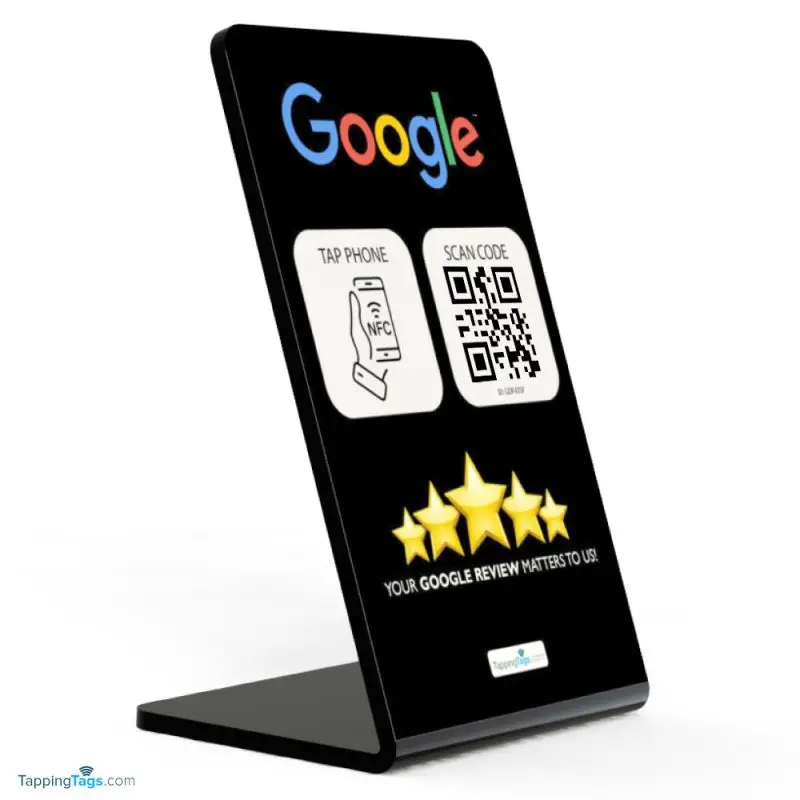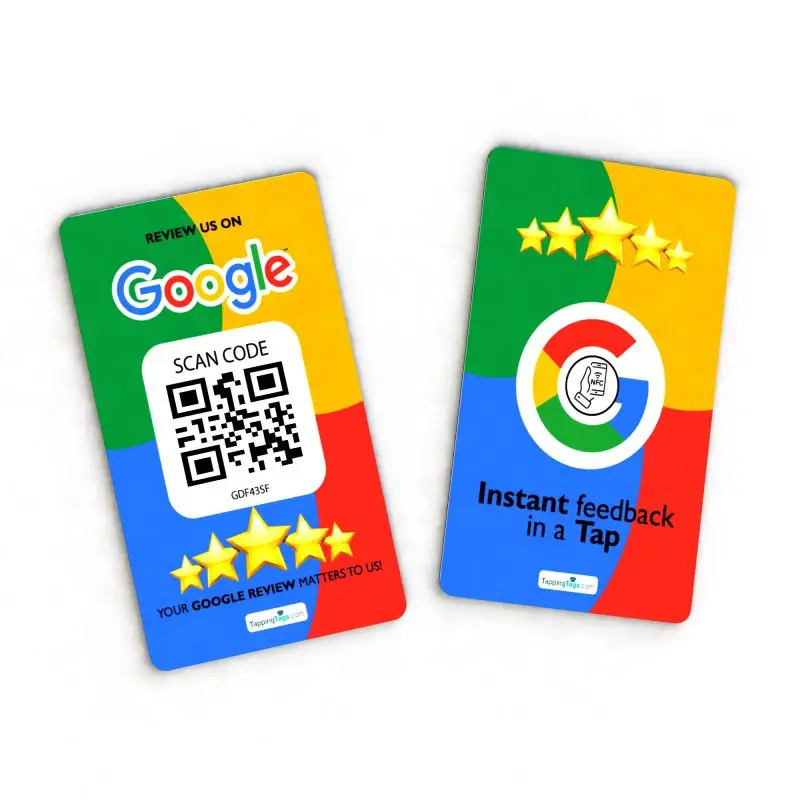Blog
NFC Cards vs. QR Codes: Which Is Better for Reviews?
In today’s digital-first world, collecting customer feedback efficiently is more important than ever for businesses aiming to enhance their online reputation and boost local SEO. When it comes to gathering reviews, two popular technologies stand out: NFC cards and QR codes. But which one is better for reviews? Tapping Tags, an innovative company at the forefront of customer feedback solutions, offers a compelling answer with its Google Review NFC card. This cutting-edge product leverages Near Field Communication (NFC) technology to simplify the review process—customers can leave a Google review with just a tap of their smartphone, no app downloads required. Unlike traditional QR codes that require scanning and sometimes additional steps, NFC cards offer a seamless, instant connection to a business’s review page. Designed for convenience, cost-effectiveness, and speed, Tapping Tags’ NFC cards are ideal for mobile services and on-the-go businesses looking to double their reviews in just 30 days. With compatibility across 90% of smartphones and a strong focus on enhancing user experience, NFC cards are quickly becoming the preferred choice for businesses serious about improving their online visibility and customer engagement.
Understanding How NFC Cards and QR Codes Work
Near Field Communication (NFC) cards and Quick Response (QR) codes are two of the most widely used technologies for facilitating digital interactions, especially in the realm of customer reviews. Both offer unique advantages and operate on different principles, making it essential to understand how each works to determine which is more suitable for your business needs.
NFC cards function through a short-range wireless communication protocol that allows data to be exchanged between devices when they are brought within a few centimeters of each other. These cards contain a small microchip and antenna, which are activated when in proximity to an NFC-enabled device such as a smartphone. Once activated, the card transmits pre-programmed information, such as a URL or contact details, directly to the user’s device. This seamless interaction eliminates the need for manual input, making it highly convenient for users. According to a report by Statista, the number of NFC-enabled smartphones worldwide is expected to surpass 2.2 billion by 2024, indicating a growing adoption of this technology.
On the other hand, QR codes are two-dimensional barcodes that can be scanned using a smartphone camera. When scanned, the code redirects the user to a specific URL, app, or digital content. QR codes are easy to generate and can be printed on various surfaces, including business cards, posters, and packaging. They do not require any special hardware to read, making them accessible to a broader audience. However, they do require the user to open their camera app or a QR code scanner, which can be a slight barrier compared to the tap-and-go nature of NFC.
One of the key differences between the two technologies lies in user experience. NFC cards offer a more intuitive and faster interaction, as users simply need to tap their phone to the card. In contrast, QR codes require multiple steps, including opening the camera, focusing on the code, and waiting for the link to appear. This difference can significantly impact user engagement, especially in high-traffic environments where speed and ease of use are crucial.
Security is another important factor to consider. NFC technology is generally considered more secure due to its short-range communication, which reduces the risk of interception. Additionally, NFC cards can be programmed with encryption protocols, adding an extra layer of protection. QR codes, while secure when used correctly, are more susceptible to phishing attacks if malicious codes are disguised as legitimate ones. According to a study by MobileIron, 71 percent of organizations expressed concerns about the security risks associated with QR codes.
From a business perspective, both technologies can be integrated into customer review strategies effectively. NFC cards can be placed at checkout counters, tables, or product displays, allowing customers to leave reviews instantly with a simple tap. QR codes can be printed on receipts, packaging, or promotional materials, offering a cost-effective way to gather feedback. However, the choice between the two should be guided by your target audience’s preferences and the context in which the technology will be used.
For example:
- A restaurant might benefit more from NFC cards placed on tables, enabling diners to quickly leave a review without interrupting their experience.
- A retail store could use QR codes on receipts, allowing customers to scan and review products at their convenience.
"The ease of use and speed of NFC technology can lead to higher customer engagement and more frequent reviews," says a report by Juniper Research.
Moreover, NFC cards offer a more premium and modern feel, which can enhance your brand image. They can be customized with your logo and branding, making them not only functional but also visually appealing. QR codes, while versatile, often lack the aesthetic appeal and can sometimes clutter your marketing materials.
To explore more about how NFC cards can elevate your customer engagement strategy, visit our shop or learn more about our innovative solutions. If you have any questions or need assistance in choosing the right technology for your business, feel free to contact us.
In conclusion, understanding the mechanics and user experience of NFC cards and QR codes is crucial for making an informed decision. While both have their merits, NFC cards often provide a smoother, more secure, and engaging way to collect customer reviews, especially in environments where convenience and speed are paramount. As digital interactions continue to evolve, businesses that adopt the right technology will be better positioned to capture valuable customer feedback and enhance their overall service quality.
Comparing User Experience and Convenience
When evaluating the user experience and convenience of NFC cards versus QR codes for collecting reviews, several key factors come into play that can significantly impact customer engagement and satisfaction. NFC cards offer a seamless and intuitive interaction. Users simply tap their smartphone on the card, and they are instantly directed to the review page without needing to open a camera or scan anything. This tap-and-go functionality is especially beneficial in fast-paced environments like retail stores, restaurants, or events where time and ease of use are crucial. On the other hand, QR codes require users to open their phone’s camera or a QR scanning app, align the code properly, and wait for the link to appear. While this process is relatively straightforward, it introduces more steps and potential friction, particularly for less tech-savvy users or in low-light conditions where scanning may be difficult.
Another aspect to consider is the physical and aesthetic appeal of each option. NFC cards are typically sleek, durable, and customizable, making them a more professional and modern choice for businesses aiming to enhance their brand image. They can be embedded into keychains, stickers, or even integrated into signage, offering flexibility in how they are presented to customers. QR codes, while functional, often appear as plain black-and-white squares that may not align with a brand’s visual identity. Additionally, NFC technology tends to be more secure and less prone to tampering compared to printed QR codes, which can be easily replaced or altered.
From a convenience standpoint, NFC cards also have the advantage of not requiring an internet connection to initiate the interaction, as the data is stored on the chip itself. This can be particularly useful in areas with poor connectivity. However, it is important to note that not all smartphones support NFC, especially older models, which could limit accessibility for some users. QR codes, being universally compatible with any camera-enabled smartphone, offer broader accessibility in this regard.
For businesses looking to streamline the review collection process, NFC cards provide a faster and more engaging experience that encourages more users to leave feedback. They reduce the number of steps involved, minimize user error, and create a more memorable interaction. To explore how NFC technology can enhance your customer engagement strategy, visit our shop or learn more about our innovative solutions. For personalized assistance or inquiries, feel free to contact us anytime.
In conclusion, both NFC cards and QR codes offer unique advantages when it comes to collecting customer reviews. NFC cards provide a seamless and modern experience with just a tap, making them ideal for tech-savvy users and high-end environments. On the other hand, QR codes are cost-effective, easy to implement, and accessible to a wider audience with smartphones. The best choice ultimately depends on your business needs, target audience, and budget. For a sleek, touchless experience, NFC might be the way to go; for simplicity and broad compatibility, QR codes could be your best bet. Whichever you choose, the key is to make the review process as easy and engaging as possible for your customers.
-
 Google Review NFC and QR Code Acrylic Stand
Rated 5.00 out of 5
Google Review NFC and QR Code Acrylic Stand
Rated 5.00 out of 5$75.00Original price was: $75.00.$38.50Current price is: $38.50. -
 Google Review NFC & QR Code Acrylic Tag with Sticker
Rated 5.00 out of 5
Google Review NFC & QR Code Acrylic Tag with Sticker
Rated 5.00 out of 5$49.00Original price was: $49.00.$27.00Current price is: $27.00. -
 Google Review NFC and QR Code Card - Tap or Scan
Rated 5.00 out of 5$18.90 – $98.90Price range: $18.90 through $98.90
Google Review NFC and QR Code Card - Tap or Scan
Rated 5.00 out of 5$18.90 – $98.90Price range: $18.90 through $98.90
